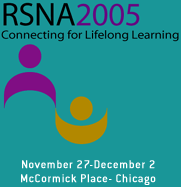
Abstract Archives of the RSNA, 2005
SST13-08
Fast MRI Measurement of Liver Fat and Clinical and Biochemical Correlates in Obese Children with Hepatic Steatosis
Scientific Papers
Presented on December 2, 2005
Presented as part of SST13: Pediatric (Gastrointestinal)
Michela Celestre MD, Presenter: Nothing to Disclose
Pasquale Paolantonio MD, Abstract Co-Author: Nothing to Disclose
Lucia Pacifico, Abstract Co-Author: Nothing to Disclose
Michele Anzidei, Abstract Co-Author: Nothing to Disclose
Andrea Laghi MD, Abstract Co-Author: Nothing to Disclose
Roberto Passariello MD, Abstract Co-Author: Nothing to Disclose
Marco Matrunola, Abstract Co-Author: Nothing to Disclose
Caterina Anania, Abstract Co-Author: Nothing to Disclose
Luisa Coletta MD, Abstract Co-Author: Nothing to Disclose
et al, Abstract Co-Author: Nothing to Disclose
Non-alcoholic fatty liver disease (NAFLD) is increasingly recognized as common cause of chronic liver disease in paediatric population. The aim of this study was to investigate, in a population of obese children, the association between the degree of hepatic fatty changes as established by fast MRI, and the anthropometric and biochemical parameters.
Forty-one obese (BMI>95th percentile for age) children (5-15 yrs), presenting hepatomegaly and/or elevated aminotransferase and/or ultrasonographic appearance of fatty liver disease were candidates for MRI assessment of hepatic steatosis. All subjects underwent dual energy x-ray absorptiometry scan measurement, and fasting serum measurement of glucose, insulin, c-peptide, leptin and lipid profile. Quantification of hepatic fatty infiltration degree was studied by application of fast gradient echo MR phase-contrast imaging (Dixon method) at 1.5 T (Magnetom, Vision Plus, Siemens; Erlange, Germany).
According to previous established criteria (JPGN 2003; 36: 54-61) a diagnosis of fatty liver was established by MRI in 12 (29%) patients with a hepatic fat fraction (FF)> 8%. Of the 12 patients, six had FF of 9 to 11%, while the remaining had a FF of 20% or higher. The degree of hepatic fat accumulation was not correlated to age, sex, BMI and fat mass as well as leptin concentrations. Linear regression analysis showed that the degree of FF was positively associated with the degree of ALT (p < 0.01) and triglycerides (p < 0.05) elevation as well as with the circulating levels of insulin (p < 0.05 ) and C-peptide (p < 0.05). Insulin resistance (as defined by HOMA) and severe steatosis represented a unique combination.
Future longitudinal studies in a larger paediatric population will validate the usefulness of MR imaging in monitoring the natural disease progression.
A.L.: is a consultant to Vital Images and conducts research projects with EZEM and General Electric.
Celestre, M,
Paolantonio, P,
Pacifico, L,
Anzidei, M,
Laghi, A,
Passariello, R,
Matrunola, M,
Anania, C,
Coletta, L,
et al, ,
Fast MRI Measurement of Liver Fat and Clinical and Biochemical Correlates in Obese Children with Hepatic Steatosis. Radiological Society of North America 2005 Scientific Assembly and Annual Meeting, November 27 - December 2, 2005 ,Chicago IL.
http://archive.rsna.org/2005/4410708.html

